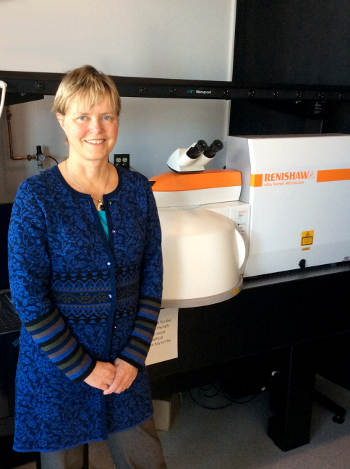Founded in 1839, Boston University has over 33,000 students. The Department of Electrical and Computer Engineering houses the Optical Characterization and Nanophotonics (OCN) laboratory.
Here, research focuses on developing, and applying, advanced optical characterization techniques to the study of solid-state and biological phenomena, at the nanoscale. The group uses Renishaw Raman spectrometers to measure strain in 2D materials and the friction between 2D materials and their underlying substrates.
 Dr Anna Swan of Boston University with her Renishaw inVia confocal Raman microscope
Dr Anna Swan of Boston University with her Renishaw inVia confocal Raman microscope
Anna Swan is an associate Professor in the Electrical and Computer Engineering Department, and one of the three directors running the multi-disciplinary lab at Boston University. The research group is currently focusing on 2D materials, such as graphene, boron nitride, molybdenum disulphide and phosphorene.
hey are interested in how strain, and designed strain fields, can be used to manipulate the electronic and optical properties in these materials. For example, a certain strain field configuration creates a magnetic pseudo field that can localize electrons and create Landau levels.
For this work, they are looking at how they can control the boundary conditions and manipulate the extent of friction between the 2D material and substrate. They are using Raman spectroscopy to measure strain, the coupling between strain and Raman shifts, and the friction.
Dr Swan and her colleagues have been using Renishaw Raman systems for a number of years, recently acquiring a new inVia confocal Raman microscope. This has become the main user instrument in the group for research and general purpose sampling.
The older Renishaw 1000 is used for specialised experiments, connected to different custom-designed chambers, for specific research under environmentally controlled conditions. The inVia provides a number of advantages such as easy switching between lasers, fast spectral mapping, automatic alignment and integrated calibration. This has made it the ‘go to system’ for the lab. These advanced features make inVia an ideal multi-user system across a wide range of different experiments.
Asked why the inVia was purchased by the lab, Dr Swan says “The performance of the 1000 system, together with the excellent support from Renishaw, made the decision an easy one for us. Although sounding a bit corny, inVia is an efficient, easy-to-use, easy-to-share system. It is pretty well perfectly suited to our requirements.”
For further details of Renishaw’s inVia confocal Raman microscope and other spectroscopy solutions, please visit www.renishaw.com/raman.